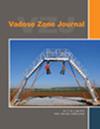Water partitioning and migration in unsaturated bentonites by low‐field NMR characterization
IF 2.8
3区 地球科学
Q3 ENVIRONMENTAL SCIENCES
引用次数: 0
Abstract
Abstract Water behavior in bentonite clay pores is influenced by soil–water interaction mechanisms such as capillary and adsorptive forces. Quantitative measurement of these water statuses remains challenging, leading to the adoption of advanced techniques. This study uses low‐field nuclear magnetic resonance (NMR) technique to investigate water partitioning dynamics and changes in the water state in sodium‐rich Wyoming bentonite and calcium‐rich Denver bentonite under various humidity conditions. NMR T 2 relaxation and T 1 – T 2 mapping techniques, along with a multi‐Gaussian decomposition method, enable a quantitative analysis of capillary and adsorptive water in both bentonites. A conceptual water partitioning model is derived to explain water molecule trajectories of water molecules under unsaturated conditions. Our findings indicate distinct transitions in hydrated layers for Na + ‐smectite and Ca 2+ ‐smectite at different relative humidity (RH) ranges. Characteristic T 2 ranges are identified for capillary and adsorptive water in both clays and provide valuable insights into their water behavior. This study advances our understanding of soil properties at different RH environments and highlights the potential of low‐field NMR techniques in characterizing capillary and adsorptive water in bentonite clays.低场核磁共振表征非饱和膨润土中水的分配和迁移
膨润土粘土孔隙中水的行为受到毛细管力和吸附力等土水相互作用机制的影响。这些水状态的定量测量仍然具有挑战性,因此需要采用先进的技术。本研究利用低场核磁共振(NMR)技术研究了富钠怀俄明州膨润土和富钙丹佛膨润土在不同湿度条件下的水分配动力学和水状态变化。核磁共振t2松弛和t1 - t2映射技术,以及多高斯分解方法,能够定量分析两种膨润土中的毛细管和吸附水。推导了一个概念水分配模型来解释水分子在不饱和条件下的运动轨迹。我们的研究结果表明,在不同的相对湿度(RH)范围内,Na + -蒙脱石和ca2 + -蒙脱石的水合层发生了明显的转变。确定了两种粘土中毛细管水和吸附水的特征t2范围,并为其水行为提供了有价值的见解。这项研究促进了我们对不同RH环境下土壤特性的理解,并强调了低场核磁共振技术在表征膨润土中毛细和吸附水方面的潜力。
本文章由计算机程序翻译,如有差异,请以英文原文为准。
求助全文
约1分钟内获得全文
求助全文
来源期刊

Vadose Zone Journal
环境科学-环境科学
CiteScore
5.60
自引率
7.10%
发文量
61
审稿时长
3.8 months
期刊介绍:
Vadose Zone Journal is a unique publication outlet for interdisciplinary research and assessment of the vadose zone, the portion of the Critical Zone that comprises the Earth’s critical living surface down to groundwater. It is a peer-reviewed, international journal publishing reviews, original research, and special sections across a wide range of disciplines. Vadose Zone Journal reports fundamental and applied research from disciplinary and multidisciplinary investigations, including assessment and policy analyses, of the mostly unsaturated zone between the soil surface and the groundwater table. The goal is to disseminate information to facilitate science-based decision-making and sustainable management of the vadose zone. Examples of topic areas suitable for VZJ are variably saturated fluid flow, heat and solute transport in granular and fractured media, flow processes in the capillary fringe at or near the water table, water table management, regional and global climate change impacts on the vadose zone, carbon sequestration, design and performance of waste disposal facilities, long-term stewardship of contaminated sites in the vadose zone, biogeochemical transformation processes, microbial processes in shallow and deep formations, bioremediation, and the fate and transport of radionuclides, inorganic and organic chemicals, colloids, viruses, and microorganisms. Articles in VZJ also address yet-to-be-resolved issues, such as how to quantify heterogeneity of subsurface processes and properties, and how to couple physical, chemical, and biological processes across a range of spatial scales from the molecular to the global.
 求助内容:
求助内容: 应助结果提醒方式:
应助结果提醒方式:


